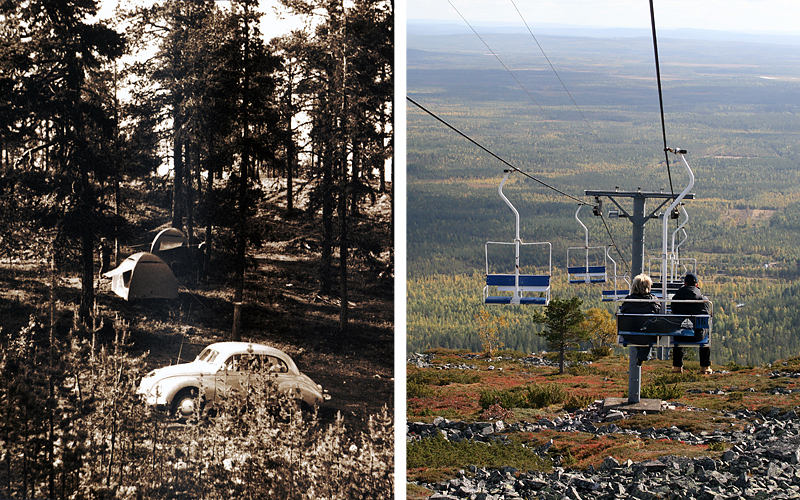”Metsähallitus complies with Government decisions”

Mr. Esa Härmälä, General Director of the Finnish state-owned forestry company Metsähallitus, is not against expanding the network of national parks. ”Though it should not be done at the expense of existing parks,” says Härmälä.
Metsähallitus consists of two segments: the business division and the nature protection division, called Park and Wildlife Finland. The main task of the Park and Wildlife division is to maintain the state-owned nature protection areas, and it is financed directly from the state budget.
The funding of the Park and Wildlife division has lately caused problems for Metsähallitus. It has not been sufficient, leading to a deficit that has affected the overall balance of Metsähallitus.
A situation where the business division would support the Park and Wildlife division was imminent, despite being prohibited by competition legislation. The problem has now been solved by entering the deficit, EUR 8.5 million, in the balance of Park and Wildlife division alone.
According to Härmälä, this is not a problem for the Park and Wildlife balance. ”The total of the balance is EUR 1.1 thousand million. What we have done is formally correct, but I doubt if it is sensible housekeeping,” says” Härmälä.
The problem is still there
The problem has not, however, been removed. If nothing further is done, the deficit will continue to increase.
This is because in the last few years, a large volume of land and buildings have been transferred to Park and Wildlife when, for example, most of the land formerly administered by the Finnish Defence Forces was handed over to Metsähallitus. ”And the basic problem is that these buildings do not create any revenue,” says Härmälä.
There have been efforts to lease the buildings to tourism enterprises, for example, but this is not something that can be achieved overnight. ”The ultimate question is whether a policy that moves a lot of non-productive buildings to an owner completely without monetary income can be successful,” asks Härmälä.
A solution to the problem is being looked for by the two ministries steering Metsähallitus, the Ministry of Agriculture and Forestry and the Ministry of the Environment.
Expenses increase while revenues drop
The finances of Parks and Wildlife are also strained by the constantly growing number of national parks. This is not understood by everyone, as seen by how Ms. Asta Tolonen, Director of the Suomussalmi municipality, argued for the proposed national park in Hossa in the newspaper Kainuun Sanomat: ”For the state, this would cost practically nothing.”
In reality, a national park creates expenses for the state, even if the land area of the park is already protected, as it is in Hossa. ”The purpose of a national park is recreation, and it needs facilities. Depending on the location, the level of services and the number of visitors, the annual cost to the state of one park is EUR 50,000–500,000,” says Härmälä.
Then again, the funding for national parks in the state budget is decreasing. ”We have only received additional funding for establishing each new park. At its peak, the funding for the Park and Wildlife division was EUR 65 million annually, but in 2016 it will drop to EUR 50 million,” says Härmälä.
It should also be remembered that even now, Finland is one of the top countries in the European Union as regards the number of national parks. Germany, with a land area bigger and a population 16 times larger than Finland, has 16 national parks. And Sweden, with an area and a population larger than Finland, has 30 parks.
Compare this to Finland’s 39 parks – and its continuous strive to establish new ones.

Towards new ways of nature protection
So are there enough national parks in Finland? ”A national park is for recreation. This is why they need to be accessible, and this has improved considerably during the last few years,” says Härmälä.
On the other hand, recreation is possible in other forests as well: in multiple-use – in other words, commercial – forests, and in forests protected for recreation purposes. Consider all these forests and you will find that almost all Finns live within a distance of ten kilometres from strictly protected forests.
Härmälä has no particular opinion on increasing the number of national parks as such. He does say that during times of increasingly scarce resources we must ensure that new parks are not set up at the expense of existing ones. ”This is a view shared by a great number of people and stakeholders in Finland today,” says Härmälä.
Then what about removing protection from ecologically less valuable protected areas, if it was compensated for by protecting some other, more valuable sites? ”We may have to consider this in connection with mining projects, for example,” says Härmälä.
According to Härmälä, some people ”wiser than me” have said that globally this type of compensation of nature values is an emerging topic of debate. ”I think the idea should be considered with an open mind,” says Härmälä and points out that nature protection in Finland is on such a high level that we have no reason to be ashamed.
”One half of the strictly protected forests in the European Union are situated in Finland. I think that instead of striving to increase the number of protected hectares we should aim at a better protection of biodiversity,” says Härmälä.
Head office is already decentralized
After the parliamentary election in April, Finland is in the process of establishing a new government. Not for the first time, there have been suggestions that the new government should move the head office of Metsähallitus away from the capital region.
Härmälä replies that ”whatever the government decides, we will of course comply with.” But again, he adds a few remarks.
”Of the 1,700 employees of Metsähallitus, 160 work from the head office. The majority of them work in the Park and Wildlife division, maintaining the protected areas in southern Finland,” says Härmälä.
The work they carry out cannot be moved elsewhere. ”For example, they maintain the nature of the islands in the Gulf of Finland. Would it be better for them to do this somewhere in the north,” asks Härmälä.
”On the other hand, even now our experts may choose where they work from according to their own will, and we consider this principle to be worth keeping. Even today, a considerable share of our nation-wide tasks are carried out somewhere other than our head office. An example is our forestry director, who works in Oulu in northern Finland,” says Härmälä.
”Considering all this, decentralizing would mean that I and one or two dozen others would move from the capital region. Though of course, this might have some kind of psychological effect,” says Härmälä.

A difficult year in timber trade
As regards the problems of Metsähallitus’s business division, they are a different kettle of fish. The state demands that Metsähallitus should pay an increasing share of its profits – mainly from forestry – to the state budget.
In 2014, the sum paid to the state coffers was EUR 135 million, which is 20 million more than the profits themselves.
Härmälä considers that an ”ambitious but realistic” baseline for the future would be EUR 120 million annually. ”This is possible if there are no problems in timber trade, the price level is appropriate, we are able to lease out our property, we manage to sell wind power permissions and in general, society functions as it should,” says Härmälä.
New investments in the forest industry are important, and of particular importance for Metsähallitus is the pulp mill planned in Kemijärvi, Lapland, because of the large harvesting potential in young forest stands in the north.
According to Härmälä, the effect of new investments should be seen in the timber market as early as in 2016, although the first substantial investment, Metsä Group’s mill in Äänekoski, Central Finland, will only be completed in 2017.
”However, as regards timber markets, this year will be difficult,” says Härmälä.
Press release of Esa Härmälä’s nomination